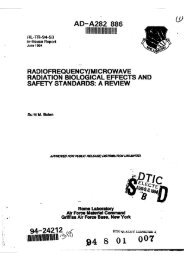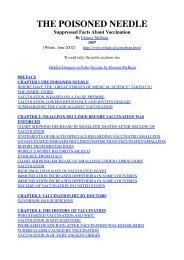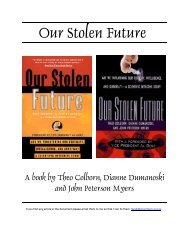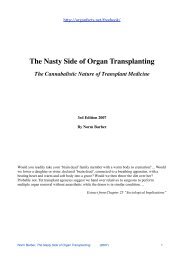Silent Weapons for a Quiet War
Silent Weapons for a Quiet War
Silent Weapons for a Quiet War
- No tags were found...
You also want an ePaper? Increase the reach of your titles
YUMPU automatically turns print PDFs into web optimized ePapers that Google loves.
THEORETICAL INTRODUCTION"Give me control over a nation's currency, and I care not who makes its laws."Mayer Amschel Rothschild (1743-1812)Today's silent weapons technology is an outgrowth of a simple idea discovered, succinctlyexpressed, and effectively applied by the quoted Mr. Mayor Amschel Rothschild. Mr. Rothschilddiscovered the missing passive component of economic theory known as economic inductance.He, of course, did not think of his discovery in these 20th century terms, and to be sure,mathematical analysis had to wait <strong>for</strong> the Second Industrial Revolution, the rise of the theoryof mechanics and electronics, and finally, the invention of the electronic computer be<strong>for</strong>e itcould be effectively applied in the control of the world economy.GENERAL ENERGY CONCEPTSIn the study of energy systems, there always appear three elementary concepts. These arepotential energy, kinetic energy, and energy dissipation. And corresponding to these concepts,there are three idealized, essentially pure physical counterparts, called passive components.In the science of physical mechanics, the phenomenon of of potential energy is associated witha physical property called elasticity or stiffness, and can be represented by a stretched spring.In electronic science, potential energy is stored in a capacitor instead of a spring. Thisproperty is called capacitance instead of elasticity or stiffness.In the science of physical mechanics, the phenomenon of kinetic energy is associated with aphysical property called inertia or mass and can be represented by a mass or a flywheel inmotion.In electronic science, kinetic energy is stored in an inductor (in a magnetic field) instead ofa mass. This property is called inductance instead of inertia.In the science of physical mechanics, the phenomenon of energy dissipation is associated witha physical property called friction or resistance, and can be represented by a dashpot or otherdevice which converts system energy into heat.In electronic science, dissipation of energy is per<strong>for</strong>med by an element called either aresistor or a conductor, the term 'resistor' being the one generally used to express theconcept of friction, and the term 'conductor' being generally used to describe a more idealdevice (e.g., wire) employed to convey electric energy efficiently from one location toanother. The property of a resistor or conductor is measured as either resistance orconductance, reciprocals.In economics these three energy concepts are associated with:Economic Capacitance -- Capital (money, stock/inventory, investments in building anddurables, etc.)Economic Conductance -- Goods (production flow coefficients)Economic Inductance -- Services (the influence of the population of industry on output).All of the mathematical theory developed in the study of one energy system, (e.g., mechanics,electronics, etc.) can be immediately applied in the study of any other energy system (e.g.,economics).MR. ROTHSCHILD'S ENERGY DISCOVERYWhat Mr. HYPERLINK "http://www.the<strong>for</strong>biddenknowledge.com/hardtruth/the_rothschild_bloodline.htm" Rothschild had discovered was the basic principle of power,influence, and control over people as applied to economics. That principle is "when you assumethe appearance of power, people soon give it to you".Mr. Rothschild had discovered that currency or deposit loan accounts had the requiredappearance of power that could be used to induce people (inductance, with peoplecorresponding to a magnetic field) into surrendering their real wealth in exchange <strong>for</strong> apromise of greater wealth (instead of real compensation). They would put up real collateral in
















